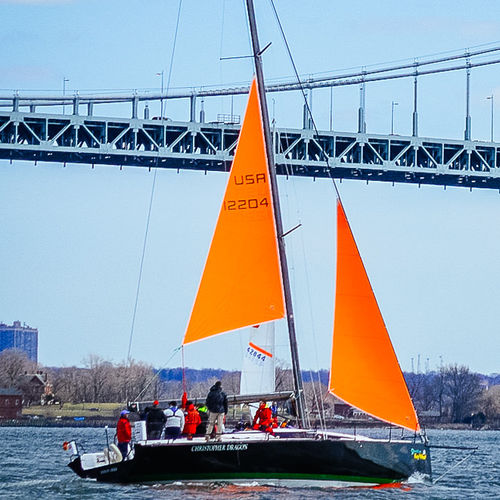
- Sailing
- Sailing Equipment and Gear
- Storm jib
- UK-Halsey International
Storm jib Trysail for cruising sailboats
Add to favorites
Compare this product
Characteristics
- Type
- storm jib
- Applications
- for cruising sailboats
Description
Bullet-proof, small and bright orange, a trysail is designed to save a boat’s mainsail from winds over 45 knots. It flies behind the mast; it is a short, triangular sail with a "droopy clew" that is sheeted to the deck or boom. The ISAF states that the trysail shall not have a headboard or battens because those hard parts could severely injure someone while flogging in high winds. To keep the unsupported edges from fluttering, the leech and the foot are concave. The storm trysail must be made out of strong woven polyester and it is recommended that the color be highly visible. This picture shows how well Storm Orange sails stand out in stormy conditions.
Trysails have a permanently attached pennant that allows the sail to be set above the gooseneck. The exact height of the trysail’s tack depends on where the sail will be sheeted – to the aft quarter or to the boom. The area of the storm trysail cannot be more than 0.175 PxE (luff measurement x foot measurement). If you ever plan to set a storm trysail, it is best to have a separate track on the mast for the sail. In a gale, it is difficult to remove the mainsail from the mast to bend on the storm trysail. Using a trysail protects your main that will be needed once the gale abates.
Tack Pennant should be marked so that the pennant can be tied off to the same spot every time the sail is used.
When the trysail's clew is attached to the boom, the main sheet can be used to trim the sail.
The "droopy clew" of the trysail allows the tack to be raised above the stack of mainsail luff cars when the sail is left on the boom.
Catalogs
No catalogs are available for this product.
See all of UK-Halsey International‘s catalogs*Prices are pre-tax. They exclude delivery charges and customs duties and do not include additional charges for installation or activation options. Prices are indicative only and may vary by country, with changes to the cost of raw materials and exchange rates.



